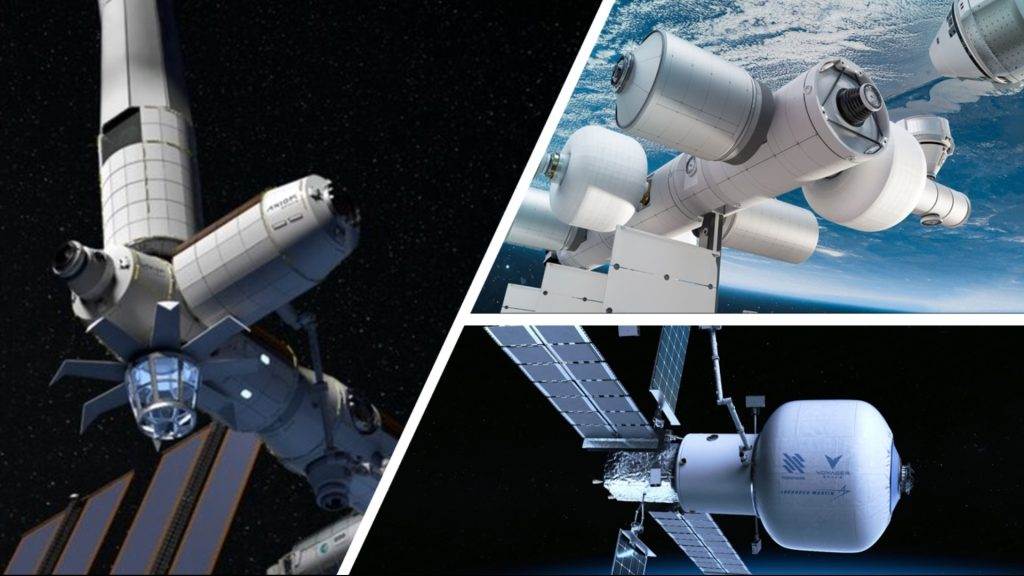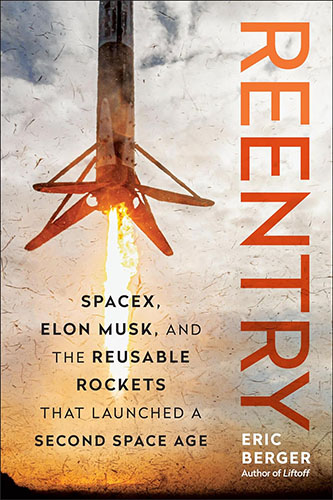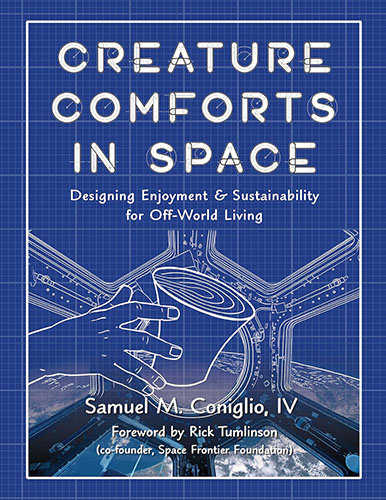By Dale Skran
Image credit: Commercial LEO stations by Axiom, Blue Origin, and Lockheed Martin
In a recent blog post I tackled the subject “What is Space Development?” [which I am assuming you have already read!] but this discussion leads rapidly to “Why Develop Space?” A more precise statement might be “Why develop space more than it is already developed?” We’ve already seen some pretty amazing forms of “space development,” including:
- Weather satellites
- Global positioning and timing services
- Satellite TV
- Communications satellites
- Earth monitoring satellites
All of these are applications where something is done in space to benefit people on the Earth. In some cases, such as GPS satellites, the services are actually provided free to all by the U.S. Government. In other cases, such as satellite TV, users subscribe to a service that might not otherwise be available in a remote area, or at a modest price. Regardless of exactly how all these space-based services are provided, it is clear that the total economic value derived from space-based services greatly exceeds the roughly $400B/year attributed to the “space economy.” This may be because it is hard to quantify the economic value associated with every person having an intelligent map in their pocket that is always up to date and can direct you to anywhere you want to go 24/7.
People are sometimes asked in a survey if the billions spent on the Moon landing were “worth it.” A far better question would be, “Since 1958 we have spent via NASA about 650 billion dollars on space in total. Over that time, space-based services have saved tens of thousands of lives from storms, guided millions to their preferred locations, allowed the U.S. military to target weapons so accurately that thousands of lives were saved, provided military intelligence that allowed nuclear weapons to be cut back, supplied key data warning us about global warming, completed billions of phone calls, and allowed you to find dates via services like Tinder and Bumble. This brief description greatly understates the value of all space derived services. Was it worth it?”
Note that the $650 billion spent by NASA in 64 years is not the total amount spent on space during this period. The military spent a significant additional amount, as did private industry. However, those entities derived direct benefits from that spending otherwise it would not have occurred. NASA spending, on the other hand, is purely discretionary and hence more challenging to justify. Further note that although $650 billion seems like a lot, that amounts to about six years of U.S. beer sales, which were $100 billion in 2021.
In truth, whatever value the Moon landings had, that amount pales compared to the total value of space derived services since 1958. So, the first and best argument for “Why develop space further?” is surely “Because it has been an enormous success so far.” The tangible benefits to every human in the USA are intuitively far more than the dollars spent by NASA. It seems totally reasonable to think that if we move space development to the next level, and start doing things like:
- Collecting carbon-free solar power and beaming it back to the Earth to replace coal and nuclear plants
- Printing retinas in space
- Growing hearts in space
- Cheap high-bandwidth global Internet connectively
- Manufacturing super-powerful fiber optic cables in space
- Filming movies in space
- Vacationing in space
- Mining rare metals and bringing them back to the Earth
That the sum of all the benefits – jobs, better health, carbon free clean power, reduced pollution from mining on the Earth, and more – will greatly exceed the value of the dollars spent. And further, much like the true value of space services such as GPS are only visible in hindsight, the full value of many of the proposed new space services will only be widely understood 50 or 100 years in the future. Say maybe after widespread use of Space Solar Power (SSP) has stopped global warming.
The above argument encapsulates most of the purely economic and “life-impacting” reasons for space development, but there are other justifications for space development.
Space solar power as a solution to climate change beckons strongly as a short-term motivation for space development. Interest has been rising rapidly in China, Japan, and ESA, with LEO to ground demonstrations promised in just a few years. Although there are numerous potential business cases in LEO, and at least a few targeted at the Moon, the biggest potential win surely is space solar power (SSP). Tens of billions are being poured into fusion annually, and scientific breakeven has yet to be demonstrated by anyone. By comparison SSP stands on a solid scientific foundation, and for the most part even the engineering issues have been resolved. Many of those who have looked at the prospects for SSP seriously find that the business case already closes for remote island and military outposts. A very good case can additionally be made that SSP works economically as baseload power to replace coal and nuclear plants, especially at latitudes far from the equator. SSP complements ground based solar, which reigns supreme as a source of daytime peaking power for air conditioning and other electricity uses that are at a maximum during regular business hours.
Space development has the potential to make space exploration less expensive [much less expensive, actually] and more effective. Imagine that for all future time, every robot, rover, helicopter, and astronaut that is sent to explore Mars must launch from the Earth, with no access to any form of waystation, fuel depot, ISRU facility on Mars, etc. I submit that this “exploration” is not going to be cheap! As an alternative, imagine that Elon Musk builds a more or less self-sufficient city on Mars that is paid for based on reasons other than scientific exploration. Now the cost of putting a person in a rover on Mars is reduced to finding someone living in Musk’s city who needs extra money, and paying them. Even if you pay them $10M/day, you will find that you get better results much less expensively than with the “send it all from Earth” approach. Detailed economic analysis is not required to suggest that in-space infrastructure lowers the cost of space exploration in ways large and small. And with extensive space development, the costs for space exploration will plummet.
It is often mentioned in passing that developing resources in space has the potential to reduce pollution on the Earth. Many mining processes on the Earth have significant environmental impacts. A quick look at the Wikipedia article on mining pollution will give you an overview. Now let’s imagine that 50% of that mining is done in space rather than on the Earth. We have just reduced the global pollution from mining by half, and if this is really happening, we are producing materials at prices competitive with those from Earth mines, and perhaps more than competitive. Some may suggest that although the mining will occur far away, in some fashion something bad will still happen. Since it is a bit unbelievable that even rather destructive mining of asteroids [not that we should use such methods!] 100 million miles from Earth might impact the Earth, we are usually asked to fear that the asteroid miners will lob asteroids at the Earth due to incompetence, for blackmail, or just out of malice. Regardless of the purported motive, we need strong defenses around the Earth for naturally incoming asteroids, and these defenses will be able to accommodate any asteroids accidently dropped toward the Earth. Actual military attacks require a more complex analysis, and another blog post! There is also a cottage industry of writers attempting to show that asteroid mining can never return materials to Earth at competitive prices relative to Earthly mining. This requires yet another blog post to examine in detail.
A possible impact of extensive space development lies in the potential that elements relatively rare and expensive on Earth, e.g., platinum, might be mined much more cheaply in the asteroids and returned to the Earth at sufficiently low prices that it becomes possible to use them in ways that are currently not cost-effective. It currently appears we may have difficulty mining enough lithium to meet the demand for batteries. These benefits are, of course, speculative, but are at least worth considering.
Another aspect of space development is more subtle – doing specific things in space such as processing oxygen out of the Martian atmosphere for rocket fuel, or creating means to efficiently mine a platinum rich asteroid may lead to secondary techniques and knowledge that have broader impact than just the greater availability of platinum. In effect, the desire to ‘develop space” creates an endless ladder of questions that demand answers. Examples such as Bell Laboratories, where revolutionary science and technology was routinely created in the pursuit of better telephone service are salutatory. Investigator-led research such as funded by the National Science Foundation plays a foundational role, but working 17 years at Bell Labs led me to the conclusion that there is something about very specific long-term questions (How can we build a better telephone system?) that generates dramatic results. A similar pursuit of developing resources in space to benefit humanity promises the same kind of secondary but tangible benefits.
Part of space development lies in the creation of infrastructure. The best current example of this is surely the International Space Station. The ISS has enormous “knock-on” effects, such as enabling the growth of SpaceX from nothing to the world’s leading launch company. A less visible impact of the ISS derives from the scientific experiments that having a continuously crewed laboratory in zero-gravity enables. As one example the Cold Atom Lab on the ISS generates a lower temperature than any equipment on the Earth since the lack of gravity infinitesimally slows the motion of atoms relative to sea level, and this greater slowness of motion lowers the minimum temperature that can be achieved. This may or may not result in some amazing discovery, but whenever humans have pushed into a completely new area of scientific investigation – in this case zero gravity – great discoveries have always followed. Thus, the establishment of scientific infrastructure in space – the ISS now, but in the future including a lunar far-side radio telescope and a crewed base on Mars – has the potential to both trigger the growth of new industries in space and to expand the frontier of knowledge in ways that could never happen with Earth based equipment alone.
Finally, just as space development makes space exploration easier, it also makes space settlement more feasible. Clearly, an extensive lunar or asteroid mining industry is an essential foundation for building O’Neill cylinders. A large-scale space hotel business in cis-lunar space forms a natural bridge to true communities in space. In fact, it is difficult to imagine space settlements coming into being without extensive foundational space development efforts. This certainly isn’t the #1 reason to support space development, but if you do believe building thriving self-governing communities throughout the solar system is essential to our long-term survival as a species, then extensive space development looms as a critical milestone.
In conclusion, the above does not fully weight the immense value of space development to the U.S. and many other countries from a military and strategic perspective, nor does it take into account the importance of “soft power” that derives from U.S. space activities. This would require a long essay to even briefly describe, but as just one point consider that US-Russian cooperation on the International Space Station may be holding us back from nuclear war, while the SpaceX Starlink constellation appears to be being used to decisive advantage by the Ukrainians against the Russians.
©2022 Dale Skran





















3 thoughts on “NEWSPACE BASICS: Why Develop Space?”
Why not ? We must develop space
I am all for space exploration and space development, but as far as our long-term survival as a species, should we not expand our efforts to develop underwater communities in our vast oceans. Easier, less expensive, safer trial and error efforts etc.
In the Winter 2023 issue of Ad Astra on page 10, I have written an article titled “The Other Final Frontier” which explains why no amount of settling the oceans on the Earth will have any meaningful impact on long-term human survival. The idea of ocean colonies is mostly a red herring.